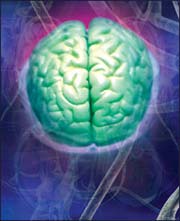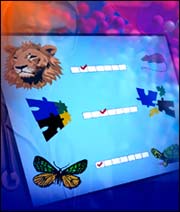Latest News

’Buckyball’ Material Brings Light into Line
Using molecules resembling 60-sided soccer balls, a joint team of researchers from the University of Toronto and Carleton University has created a new material for processing information using light.
Led by U of T electrical and computer engineering professor Ted Sargent and Carleton University chemistry professor Wayne Wang, the team developed a material that combines microscopic spherical particles known as “buckyballs” with polyurethane, the polymer used as a coating on cars and furnitur

Control of Gene Expression Demonstrated
Intervention in the process whereby genes are turned “on” or “off” has been demonstrated by scientists at the Hebrew University-Hadassah Medical School. The work offers promise for future genetic treatment to control undesirable tissue growth, such as in cancer.
The experimental work of the group is described in a recent article in the journal, Nature Genetics. The researchers succeeded in showing how manipulation of the methylation process in animals can turn genes which are normally inacti

Mind games: Rescuing human survival from the maelstrom of everyday change
The meaning and nature of change is a question that has fascinated some of the world’s greatest minds since long before the birth of Christ. Today, legions of philosophers and hosts of cognitive scientists continue to work to resolve what may be one of the world’s greatest paradoxes: How is it that change and constancy coexist in the world and in the human mind? Binghamton University Professor Eric Dietrich is sure of at least one thing. Our creativity, and likely our very survival, depends on the f

A picture perfect test of well-being: Graphic assessment tool tunes into life satisfaction
After working at it for the past decade, gerontologist and Dean of the Decker School of Nursing Sarah Gueldner has led a team of colleagues from institutions the world over in the development of a unique research tool to quantifiably measure almost anyone’s sense of well-being. Refined across four countries and three continents, with the help of more than 3,000 study participants, the instrument looks as if it was torn from the pages of a children’s coloring book and can be completed with a crayon.

Powerful new method helps reveal genetic basis of cancer
Plus surprising differences in ’Normal’ DNA
Researchers at Cold Spring Harbor Laboratory have developed one of the most sensitive, comprehensive, and robust methods that now exists for profiling the genetic basis of cancer and other diseases. The method detects chromosomal deletions and amplifications (i.e. missing or excess copies of DNA segments), and is useful for a wide variety of biomedical and other applications.
The study, led by Rob Lucito and Michael Wigler, is pub

Sick Kids researchers identify cancer stem cell for brain tumours
A research team at The Hospital for Sick Children (HSC) and the University of Toronto (U of T), led by Dr. Peter Dirks, has identified for the first time a cancer stem cell in both malignant and benign brain tumours. This discovery may change how brain tumours are studied and how this deadly condition is treated in the future. This research is reported in the September 15, 2003 issue of the scientific journal Cancer Research.
“The discovery of a cancer stem cell for brain tumours means that











